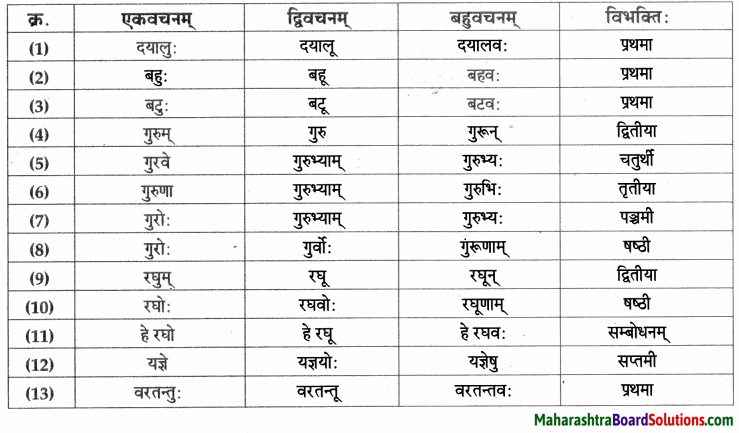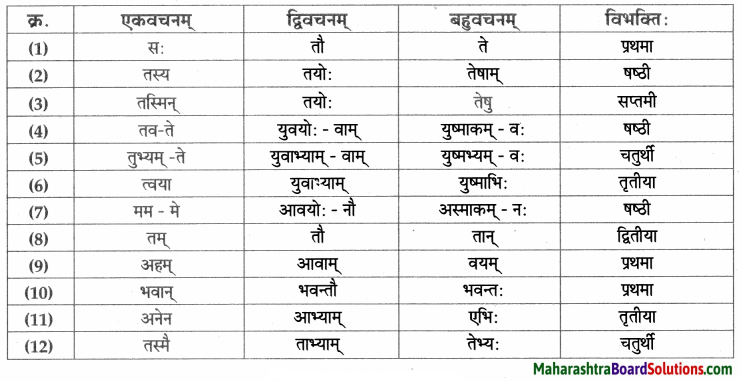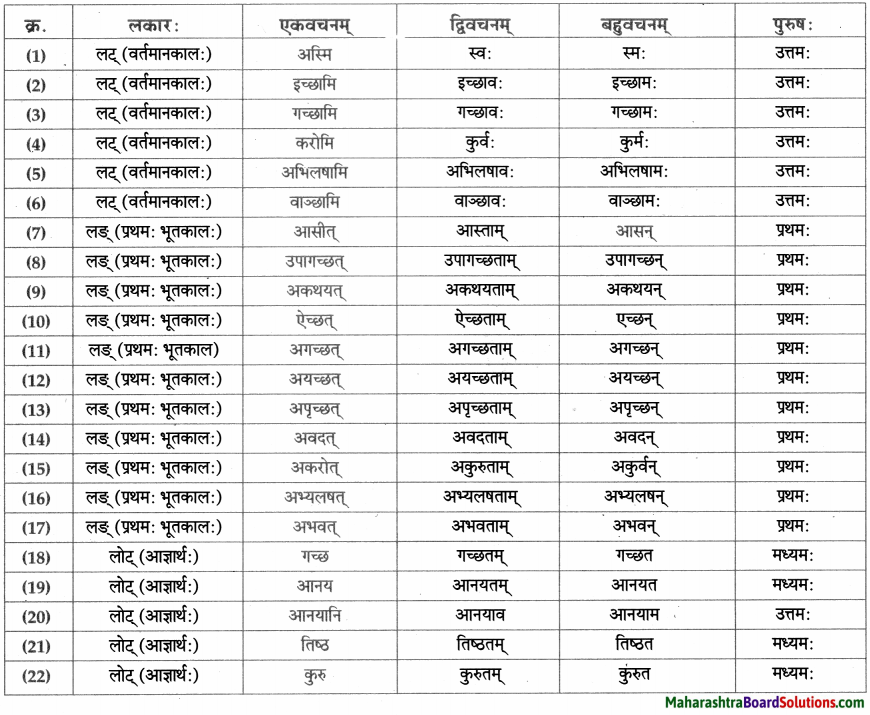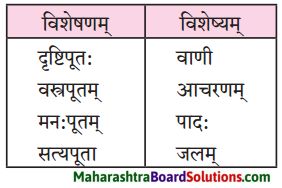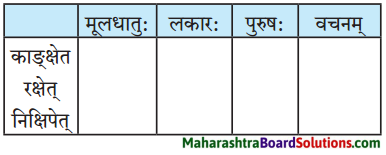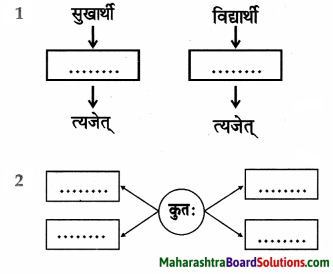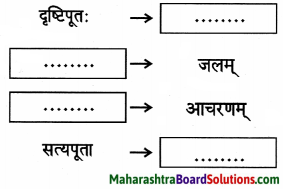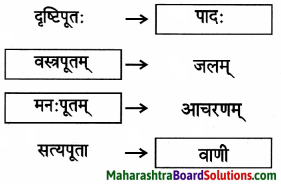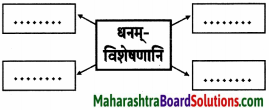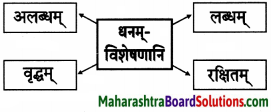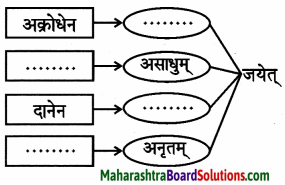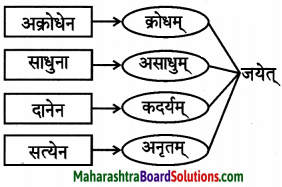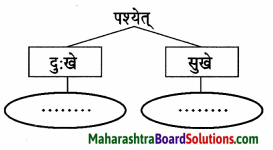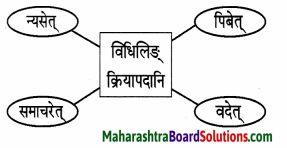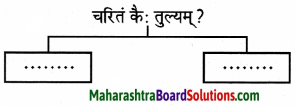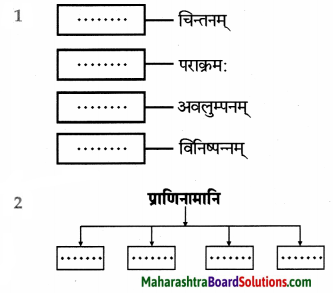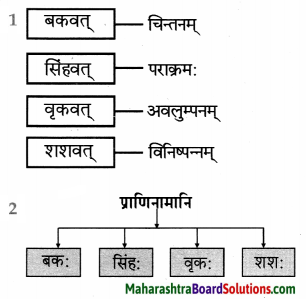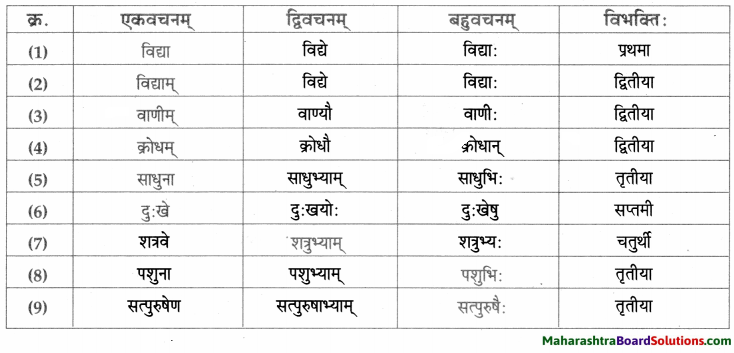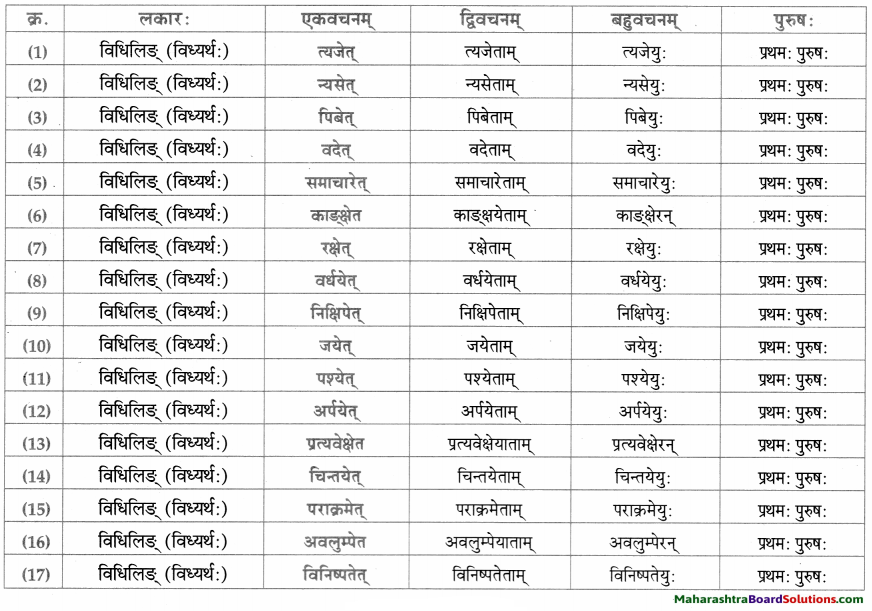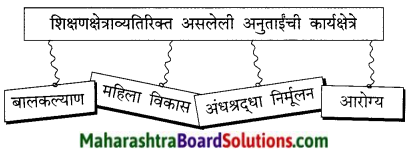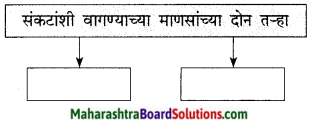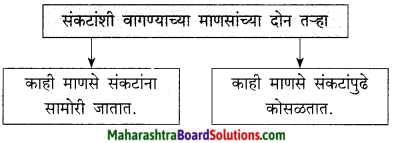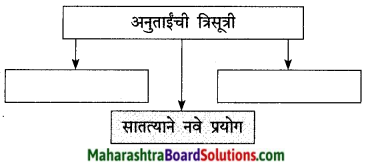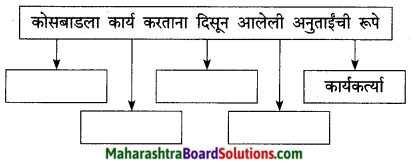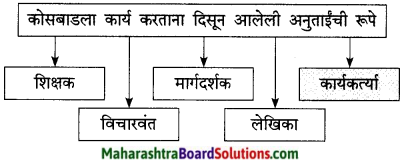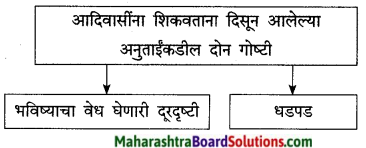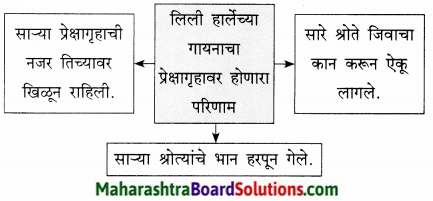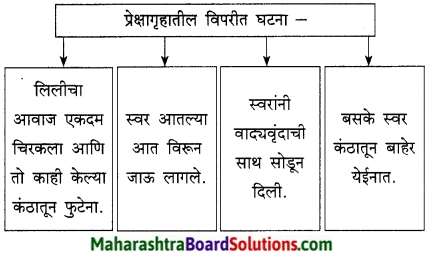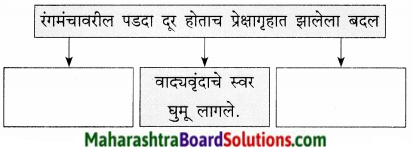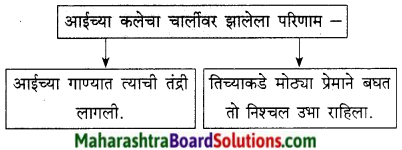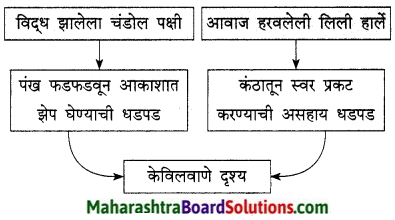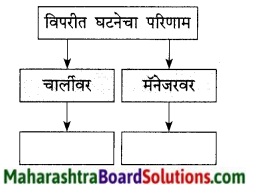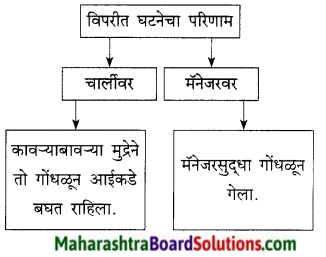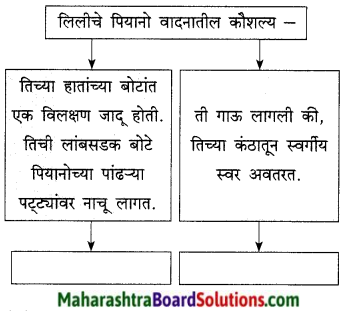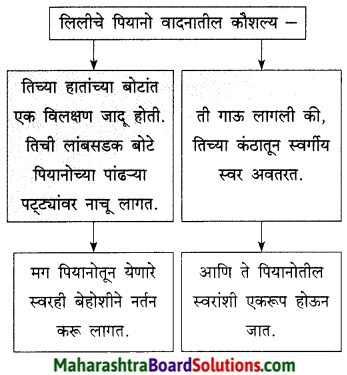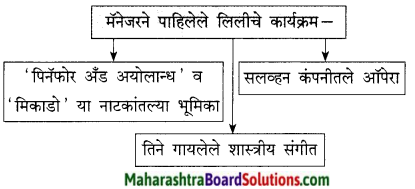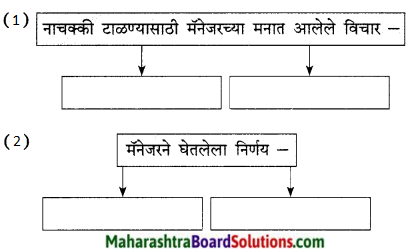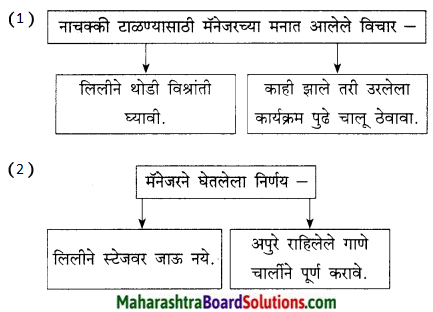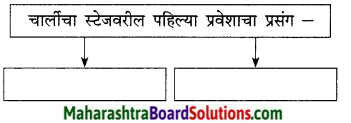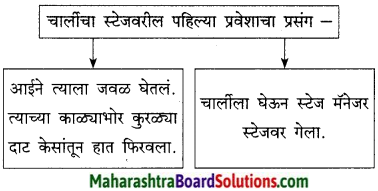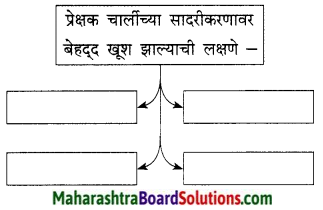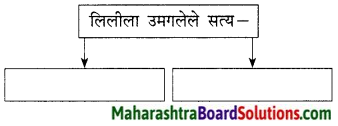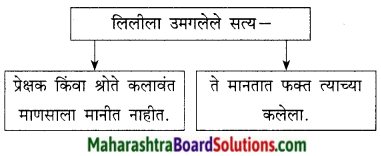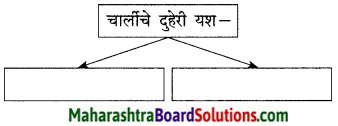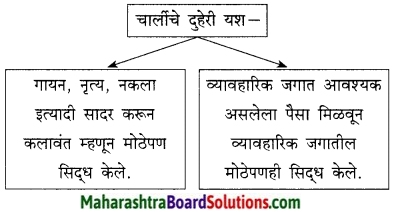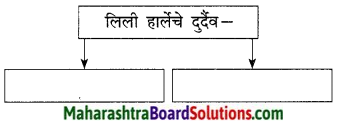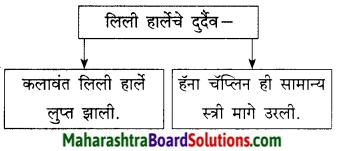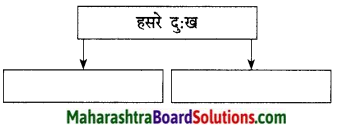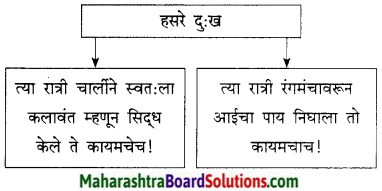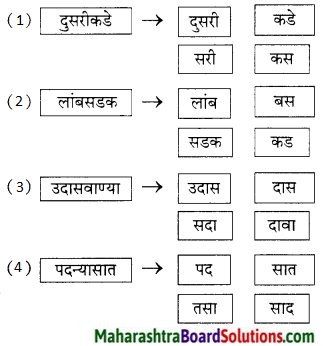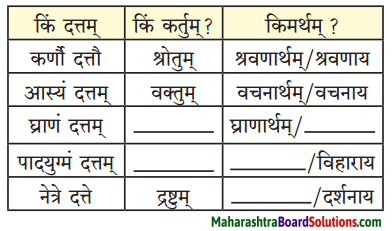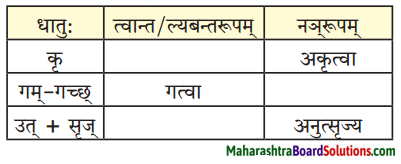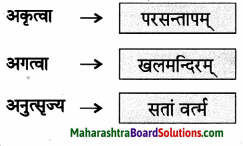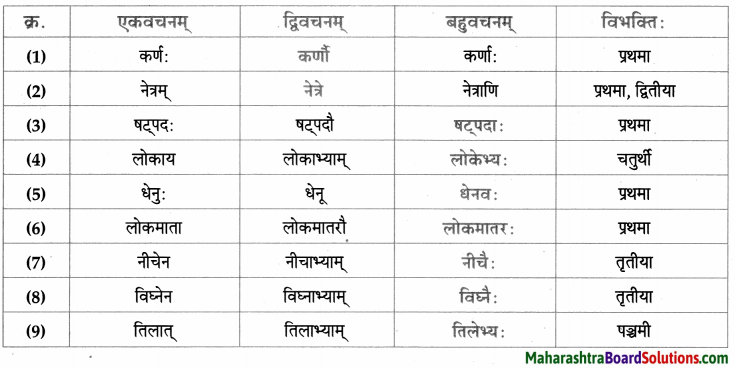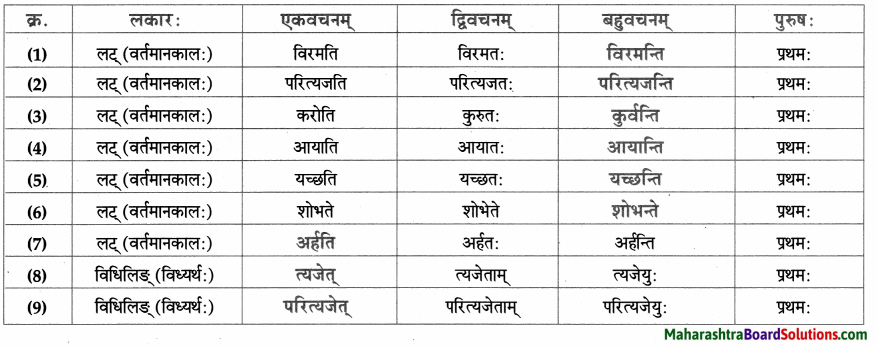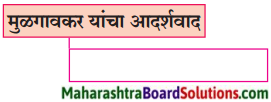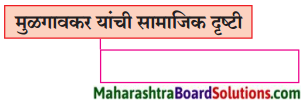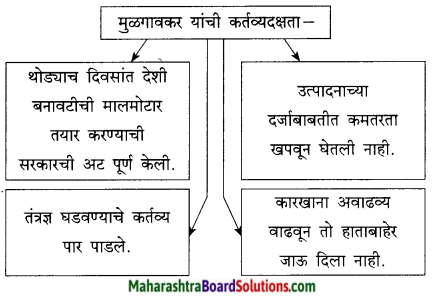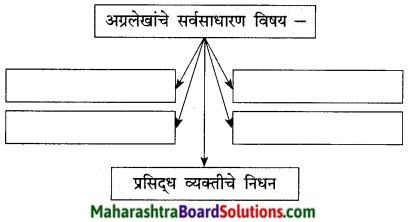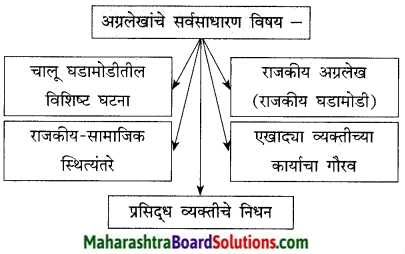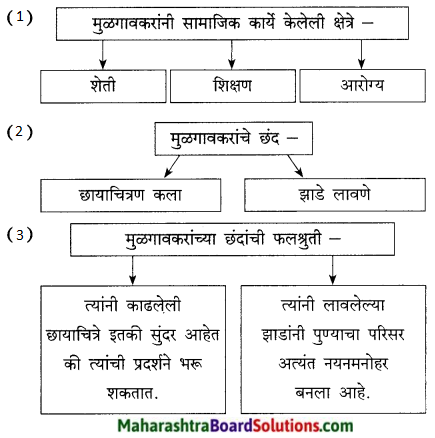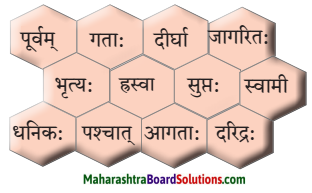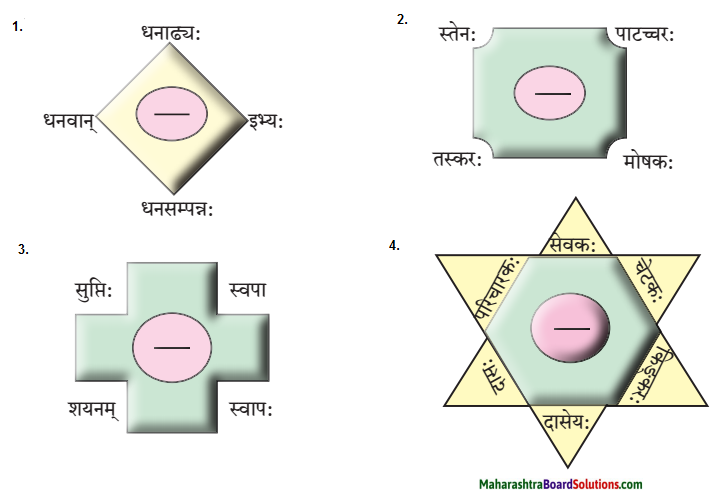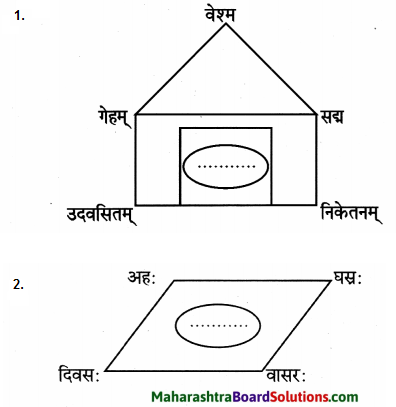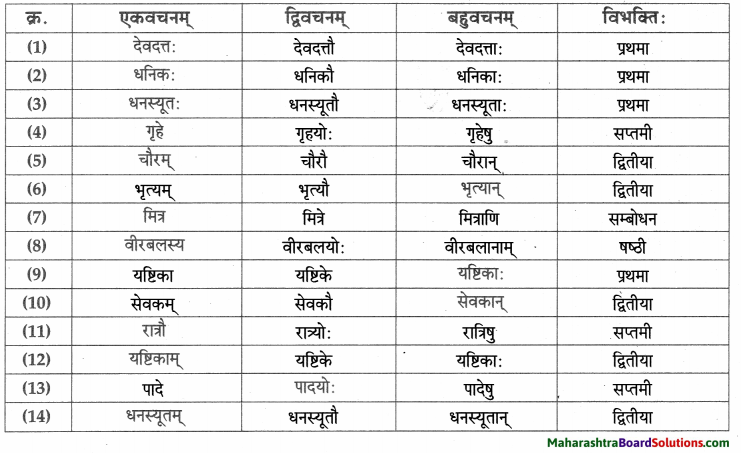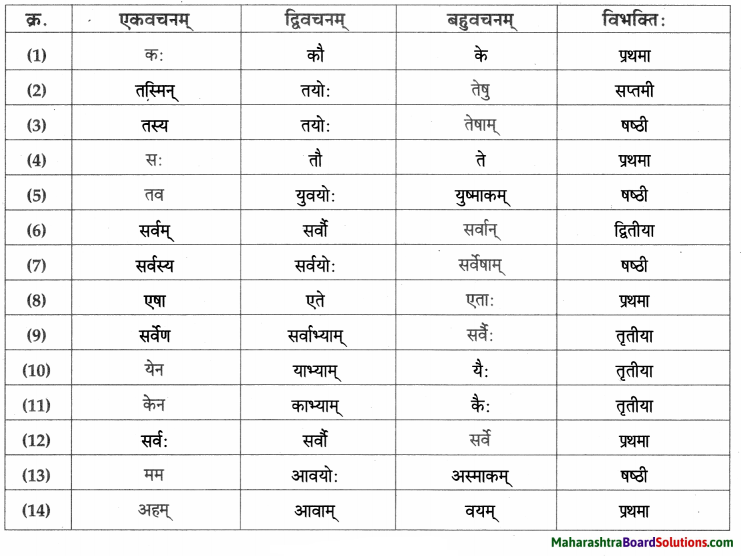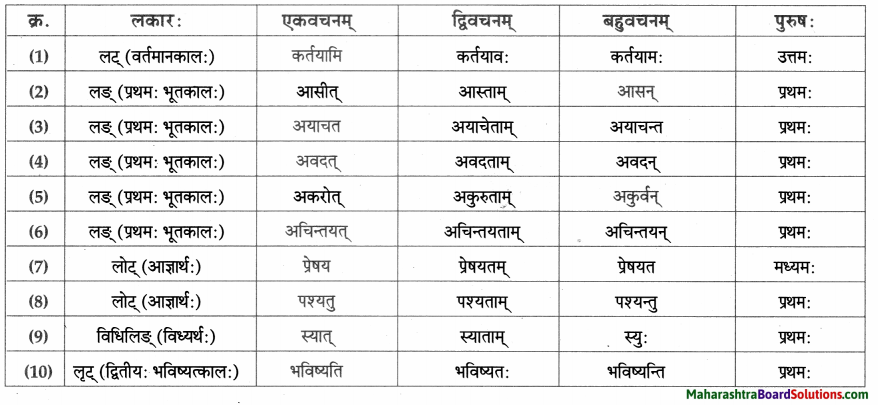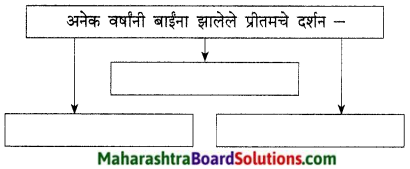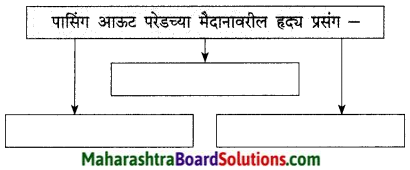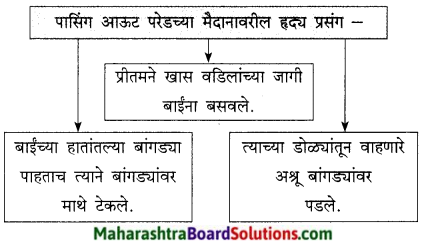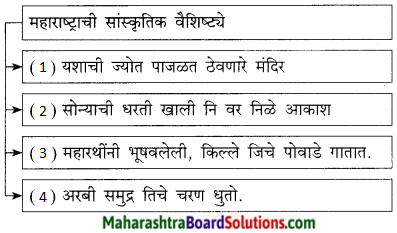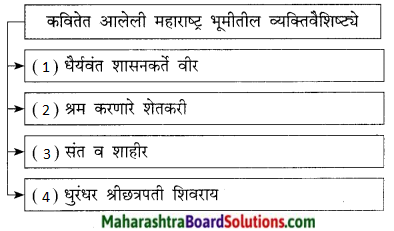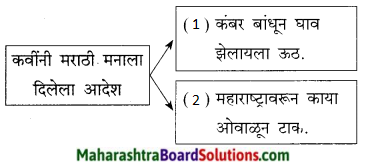Balbharti Maharashtra State Board Class 9 Sanskrit Solutions Aamod Chapter 10 पितृभक्तः नचिकेताः Notes, Textbook Exercise Important Questions and Answers.
Maharashtra State Board Class 9 Sanskrit Aamod Solutions Chapter 10 पितृभक्तः नचिकेताः
Sanskrit Aamod Std 9 Digest Chapter 10 पितृभक्तः नचिकेताः Textbook Questions and Answers
भाषाभ्यास:
1. एकवाक्येन उत्तरत।
प्रश्न अ.
वाजश्रवाः कः ?
उत्तरम् :
वाजश्रवाः दानपर: ब्राह्मणः।
प्रश्न आ.
दक्षिणायां किं यच्छेत् इति नियमः ?
उत्तरम् :
दक्षिणायां सर्वदा प्रियं वस्तु यच्छेत् इति नियमः।
![]()
प्रश्न इ.
वाजश्रवसः पुत्रः कः ?
उत्तरम् :
बाजश्रवस: पुत्र: नचिकेताः।
प्रश्न ई.
तृतीयवररूपेण नचिकेताः किम् अयाचत ?
उत्तरम् :
तृतीयवररूपेण नचिकेता: आत्मज्ञानम् अयाचत।
प्रश्न उ.
बालः नचिकेताः कति दिनानि यावत् यमस्य प्रतीक्षाम् अकरोत् ?
उत्तरम् :
बाल: नचिकेता: त्रीणिदिनानि यावत् यमस्य प्रतीक्षाम् अकरोत्।
![]()
2. माध्यमभाषया उत्तरत।
प्रश्न अ.
नचिकेता: यमपुरं किमर्थम् अगच्छत् ?
उत्तरम् :
‘पितृभक्त: नचिकेता: ही लहान पण अतिशय प्रगल्भ अशा ज्ञानपिपासू नचिकेताची कथा आहे. नचिकेताने आपले वडील वाजश्रवा यांना विश्वजित् यज्ञ संपन्न झाल्यावर भाकड गायी दक्षिणा म्हणून देताना पाहिले. दक्षिणा म्हणून सर्वात प्रिय वस्तू द्यावी असा नियम होता, त्यामुळे अयोग्य दक्षिणा देण्याचे पाप लागून आपले वडील नरकात जातील की काय अशी नचिकेताला भिती वाटली.
त्याने वडिलांना विचारले “तुम्हाला सर्वात प्रिय असे काय आहे?” वडिलांनी त्याला लगेच सांगितले की नचिकेताच त्यांना सर्वात प्रिय आहे. नचिकेताने हे ऐकून त्यांना विचारले. “मग तुम्ही मला कोणाला दान करणार?” वडिलांनी दुर्लक्ष करुन सुद्धा नचिकेता तोच प्रश्न विचारत राहिला.
शेवटी चिडून वाजश्रवा म्हणाला “मी तुला मृत्यूला देईन!” वडील चिडून बोलत हे कळूनसुद्धा वडिलांच्या आज्ञेचे पालन करायचे आहेत म्हणून नचिकेता यमाच्या घरी गेला. नचिकेता इतका आज्ञाधारी मुलगा होता की वडिलांची आज्ञा मोडायची नाही म्हणून मृत्यूच्या घरी जाताना सुद्धा त्याने किंचितसाही विचार केला नाही. वडिलांच्या आज्ञेचे पालन करण्यासाठी तो अतिशय तत्पर होता.
In the lesson ‘पितृभक्त: नचिकेता:’ there is story of a small boy Nachiketa who was very thirsty for knowledge. Once the little Nachiketa saw his father giving the old, unmilkable cows in charity to the Brahmins after performing Vishwajit sacrifice.
But the rule was that the most beloved thing has to be given in donation. So Nachiketa was scared that his father might attain hell if he performs improper donation. So he asks his father what was the most dear to him. His father answered that Nachiketa was most dear to him.
So Nachika asked whom he would be given to. Nachiketa kept asking this again and again even when his father ignored him. Nachiketa didn’t give up. His father got angry and told him that he would give him to the death. He knew that his father said so in anger.
Still, he went to the abode of Yama to follow his Father’s order. Nachiketa was such a well-behaved son that he didn’t even think once before following his father’s order.
![]()
प्रश्न आ.
के त्रयः वरा: नचिकेतसा याचिताः ?
उत्तरम् :
‘पितृभक्त नचिकेता’ या पाठामध्ये यम-नचिकेता संवाद आला आहे. या संवादातून नचिकेताची जिज्ञासू वृत्ती दिसून येते. वडिलांची आज्ञा पाळण्यासाठी नचिकेता यमाच्या घरी गेला तेव्हा यम तिथे नव्हता. नचिकेताने काहीही न खाता पिता तीन दिवस यमाची वाट पाहिली. चौथ्या दिवशी यम परतला तेव्हा त्याला लहानग्या नचिकेताची खूप दया आली.
नचिकेता तीन दिवस तिथे थांबला म्हणून यमाने नचिकेताला तीन वर मागण्यास सांगितले. नचिकेताने वडिलांचा राग जाऊ दे असा पहिला वर मागितला आणि स्वर्ग प्राप्त करून देणारी अशी अग्निविद्या दुसरा वर म्हणून मागितली. तिसरा वर म्हणून नचिकेताने सामान्य माणसाला तसेच भल्या भल्या विद्वानांनासुद्धा मिळवण्यासाठी अशक्यप्राय असणारे असे आत्मज्ञान मागितले. नचिकेता वयाने लहान असला तरी सुद्धा त्याला असामान्य अशी बुद्धी आणि ज्ञानपिपासा लाभली होती.
In the story ‘पितृभक्त : नचिकेता:’ an incident of small Nachiketa who is eager to attain the ‘knowledge of self is told. When Nachiketa went to Antioch to obey his father’s order. But Yama was not there. Nachiketa waited there for three days, without eating or drinking anything.
When Yama returned on the fourth day his heart went out of compassion for Nachiketa. Yama offered Nachiketa three boons. Nachiketa asked to let his father’s anger get pacified as the first boon and the Agnividya as the second one.
As the third boon, he asked for knowledge of the self which was very difficult to attain even for the learned let alone a normal human being Even if he was young Nachiketa was blessed with immense maturity and great and thirst for knowledge.
Sanskrit Aamod Class 9 Textbook Solutions Chapter 10 पितृभक्तः नचिकेताः Additional Important Questions and Answers
एकवाक्येन उत्तरत।
प्रश्न 1.
वाजश्रवाः दक्षिणारूपेण का: अयच्छत् ?
उत्तरम् :
वाजश्रवा दक्षिणारूपेण दुग्धदाने असमर्था: दुर्बला: वृद्धा: च धेनू: अयच्छत्।
प्रश्न 2.
वाजश्रवस: प्रियः कः अस्ति?
उत्तरम् :
वाजश्रवस: प्रिय: स्वपुत्र: नचिकेता: अस्ति।
प्रश्न 3.
नचिकेता: किमर्थं यमपुरम् अगच्छत्?
उत्तरम् :
नचिकेताः पितुः आदेशपालनार्थ यमपुरम् अगच्छत्।
![]()
प्रश्न 4.
यमः किमर्थ चकित: अभवतः?
उत्तरम् :
अल्पवयसः बालस्य प्रगल्भा ज्ञानतृष्णां दृष्ट्वा यमः चकितः अभवतः।
प्रश्न 5.
यम: नचिकेतसे कति वरान् अयच्छत्?
उत्तरम् :
यम: नचिकेतसे त्रीन् वरान् अयच्छत्।
सत्यं वा असत्यं लिखत।
प्रश्न 1.
- वाजश्रवाः नाम दानपर: द्विज: आसीत्।
- वाजश्रवाः सबलाः धेनू: अयच्छत्।
- असमीचीनदानेन पिता स्वर्ग गमिष्यति इति नचिकेतस: भीतिः ।
- पिता क्रोधावेशे उक्तवान् इति नचिकेता: न अजानात् ।
- नचिकेता: त्रीणि दिनानि यावत् यमस्य प्रतीक्षाम् अकरोत्।
- पिता कुद्धः अभवत्।।
- प्रथमवररूपेण नचिकेता: आत्मज्ञानम् अयाचत।
- यमः तृतीयं वरं न अथच्छत्।
उत्तरम् :
- सत्यम्
- असत्यम्
- असत्यम्
- असत्यम्
- सत्यम्
- सत्यम्
- असत्यम्
- असत्यम्
![]()
कः कं वदति।
प्रश्न 1.
- वत्स, त्वमेव मम प्रियतमः।
- किं तव अतीव प्रियम्?
- “तर्हि मां कस्मै दास्यति, भवान् ?”
- “अहं त्वां मृत्यवे ददामि”।
उत्तरम् :
- वाजश्रवाः नचिकेतसं वदति।
- नचिकेता: वाजश्रवसं वदति।
- नचिकेता: वाजश्रवसं वदति।
- वाजश्रवाः नचिकेतसं वदति।
प्रश्न 2.
“स्वर्गसाधिकाम् अग्निविद्यां दत्त्वा माम् अनुगृह्णातु।”
उत्तरम् :
नचिकेता: यमं वदति।
![]()
शब्दस्य वर्णविग्रहं कुरुत।
- दक्षिणायाम् – द् + अ + क् + ष् + इ + ण् + आ + य् + आ + म्।
- असमर्थाः – अ + स् + अ + म् + अ + र् + थ् + आः।
- वाजश्रवाः – व् + आ + ज् + अ + श + र् + अ + व् + आ:।
- यज्ञम् – य् + अ + ज् + ञ् + अ + म्।
- क्रुद्धः – क् + र् + उ + द् + ध् + अः।
- नचिकेतसम् – न् + अ + व् + इ + क् + ए + त् + अ + स् + अ + म्।
- तर्हि – त् + अ + र् + ह् + इ।
- त्रिवारम् – त् + र् + इ + व् + आ + र् + अ + म्।
- क्षुधातेम – क् + ष् + उ + ध् + आ + र + त् + अ + म्।
- दृष्ट्वा – द् + ऋ + ष् + ट् + व् + आ।
- क्रोध: – क् + र + ओ + ध् + अः।
- प्रगल्भा – प् + र + अ + ग् + अ + ल् + भ् + आ।
![]()
प्रश्ननिर्माणं कुरुत।
- वाजश्रवाः नाम दानपर: ब्राह्मणः आसीत्।
- वाजश्रवाः विश्वजित्-यज्ञम् अकरोत्।
- दक्षिणायां प्रियं वस्तु यच्छेत्।
- अहं त्वां मृत्यवे दास्यामि।
- स: यमपुरम् अगच्छत्।
- स: त्रीणि दिनानि यावत् प्रतीक्षाम् अकरोत्।
- पितुः आदेशपालनार्थ नचिकेताः यमपुरम् अगच्छत्।
- चतुर्थ दिवसे यम: यमपुरं प्राप्तः।
- नचिकेता: आत्मज्ञानम् अयाचत।
- नचिकेतस: निर्णयः निश्चलः।
उत्तरम् :
- क: दानपर: ब्राह्मण: आसीत् ?
- वाजश्रवाः किम् अकरोत्?
- दक्षिणायां कीदृशं वस्तु यच्छेत्?
- अहं त्वां कस्मै दास्यामि?
- सः कुत्र अगच्छत्?
- स: कति दिनानि यावत् प्रतीक्षाम् अकरोत्?
- नचिकेता: किमर्थं यमपुरम् अगच्छत्?
- यमः कदा यमपुरं प्राप्त:?
- नचिकेताः किम् अयाचत?
- नचिकेतस: निर्णयः कीदृशः?
![]()
विशेषण-विशेष्य-सम्बन्धः।
प्रश्न 1.
गद्यांशात् “धेनवः” इति पदस्य कृते विशेषणानि लिखत।
उत्तरम् :
असमर्थाः, दुर्बलाः, वृद्धाः।
प्रश्न 2.
| विशेषणम् | विशेष्यम् |
| त्रीणि | पिता |
| कुद्धः | यमः |
| अनुपस्थितः | दिनानि |
| प्रथमम् | यमः |
| शान्त: | आत्मज्ञानम् |
| चकित: | वरम् |
| दुर्लभम् | क्रोध: |
उत्तरम् :
| विशेषणम् | विशेष्यम् |
| त्रीणि | दिनानि |
| कुद्धः | पिता |
| अनुपस्थितः | यमः |
| प्रथमम् | वरम् |
| शान्त: | क्रोध: |
| चकित: | यमः |
| दुर्लभम् | आत्मज्ञानम् |
![]()
विभक्त्यन्तरूपाणि।
- प्रथमा – वाजश्रवाः, सः, बाह्मणः, वस्तु, पिता, पुत्रः, त्वम्, नचिकेताः, किम्, नचिकेताः, पिता, दिनानि, वाजश्रवाः, यमः हृदयम्, बालकः, मर्त्यः, ज्ञातुकामः, नचिकेताः।
- द्वितीया – पितरम्, यज्ञम, दक्षिणाम्, नचिकेतसम्, यमपुरम, प्रतीक्षाम्, वरम्, अग्निविद्याम्, माम्, प्रार्थनाम्, नचिकेतसम्।
- तृतीया – दक्षिणारूपेण, भीत्या, वाजश्रवसा, नचिकेतसा, आनन्देन, प्रलोभनैः।
- चतुर्थी – ब्राह्मणेभ्यः, कस्मै, मृत्यवे, तस्मै।
- पञ्चमी – तृतीयवरात्।
- षष्ठी – मम, तस्य, तव, यमस्य, पितुः, मम, जनकस्य, वाजश्रवसः, तस्य, नचिकेतसः।
- सप्तमी – दक्षिणायाम्, यज्ञे, यमपुरे, क्रोधावेशे, चतुर्थे, दिवसे, अन्ते।
लकारं लिखत।
- आसीत् – अस् धातुः द्वितीयगणः परस्मैपदं लङ्लकार: प्रथमपुरुष: एकवचनम्।
- अकरोत् – कृ धातुः अष्टमगण: उभयपदम् अत्र परस्मैपदं प्रथमपुरुष: एकवचनम्।
- अयच्छत् – ‘दा-यच्छ्’ प्रथमगणः परस्मैपदं लङ्लकार: प्रथमपुरुष: एकवचनम्।
- गमिष्यति – गम्-गच्छ् धातुः प्रथमगणः परस्मैपदं लुट्लकार: प्रथमपुरुष: एकवचनम्।
- यच्छेत – दा-यच्छ् धातुः, प्रथमगणः, परस्मैपदं, विधिलिङ्लकार: प्रथमपुरुषः एकवचनम्।
- दास्यति – दा धातुः प्रथमगण: तृतीयगण: परस्मैपदं लुट्लकार: प्रथमपुरुष: एकवचनम्।
- ददामि – दा धातुः तृतीयगणः उभयपदम् अत्र परस्मैपदं लट्लकार: उत्तमपुरुषः एकवचनम्।
- अवदत् – वद् धातुः प्रथमगणः परस्मैपदं लङ्लकार: प्रथमपुरुष: एकवचनम्।
- अजानात् – ज्ञा धातुः नवमगणः उभयपदम् अत्र परस्मैपदं लङ्लकारः प्रथमपुरुष: एकवचनम्।
- अद्रवत् – द्रु-द्रव् धातुः प्रथमगणः परस्मैपदं लङ्लकार: प्रथमपुरुष: एकवचनम्।
- याचस्व – याच् धातुः प्रथमगण: आत्मनेपदं लोट्लकार: मध्यमपुरुषः एकवचनम्।
- अयाचत – याच् धातुः प्रथमगण: आत्मनेपदं लङ्लकार: प्रथमपुरुष: एकवचनम्।
- अनुगृह्यतु – अनु + ग्रह् धातुः नवमगण: उभयपदम् अत्र परस्मैपदं लोट्लकार : प्रथमपुरुष: एकवचनम्।
- उपादिशत्- उप् + दिश् धातुः षष्ठगण: उभयपदम् अत्र परस्मैपदं लङ्लकारः प्रथमपुरुष: एकवचनम्।
![]()
उचितं पर्यायं चिनुत ।
प्रश्न 1.
अहं त्वां ……………… ददामि।
(अ) मृत्यवे
(आ) इन्द्राय
उत्तरम् :
(अ) मृत्यवे
प्रश्न 2.
यमपुरे यमः ……………… ।
(अ) अनुपस्थितः
(आ) उपस्थितः
उत्तरम् :
(अ) अनुपस्थितः
प्रश्न 3.
नचिकेता: …………….. दिनानि यावत् प्रतीक्षाम् अकरोत्।
(अ) चत्वारि
(आ) त्रीणि
उत्तरम् :
(आ) त्रीणि
प्रश्न 4.
………….. यमपुरम् अगच्छत्।
(अ) भिक्षाटनार्थम्
(आ) आदेशपालनार्थम्
उत्तरम् :
(आ) आदेशपालनार्थम्
![]()
त्वान्त/ल्यबन्त/तुमन्त अव्ययानि।
| त्वान्त अव्यय धातु + त्वा / ध्वा / ट्वा / ढ्वा / इत्वा अयित्वा | ल्यबन्त अव्यय उपसर्ग + धातु + य / त्य | तुमन्त अव्यय थातु + तुम् / धुम् / टुम् / ढुम् / इतुम् / अयितुम् |
| भूत्वा अपी त्वा अभुक्त्वा दृष्ट्वा | – | – |
| श्रुत्वा | – | निवारयितुम् |
| दृष्ट्वा | – | – |
समानार्थकशब्दं योजयित्वा वाक्यं पुनर्लिखत।
1. यज्ञ: – सः विश्वजित् – यज्ञम् अकरोत्। – स: विश्वजित्-यागम् अकरोत्।
2. पुत्रः – तस्य पुत्र: नचिकेता: अपश्यत्। – तस्य आत्मज: नचिकेता: अपश्यत् ।
![]()
व्याकरणम् :
नाम – तालिका।
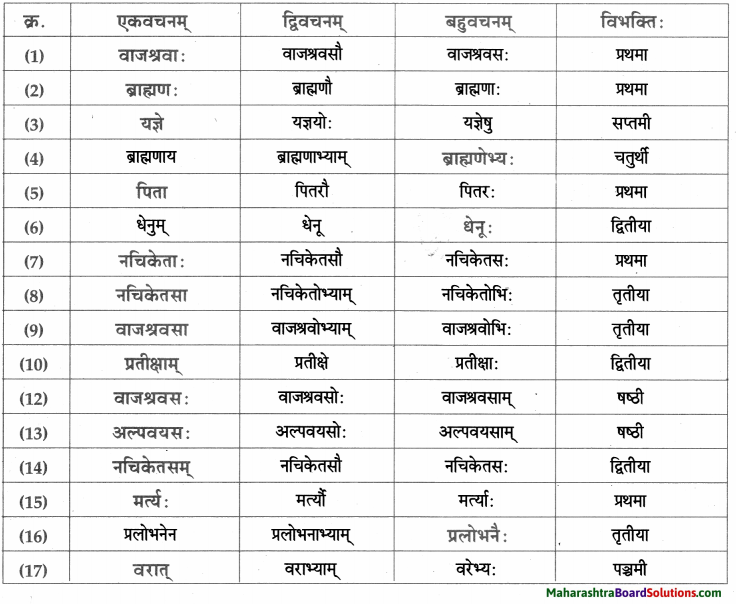
सर्वनाम – तालिका।
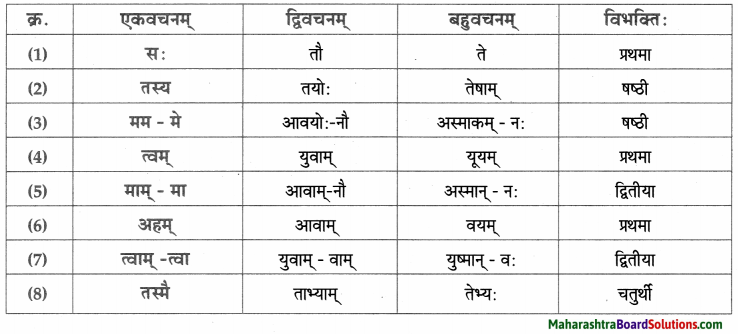
धातु – तालिका।
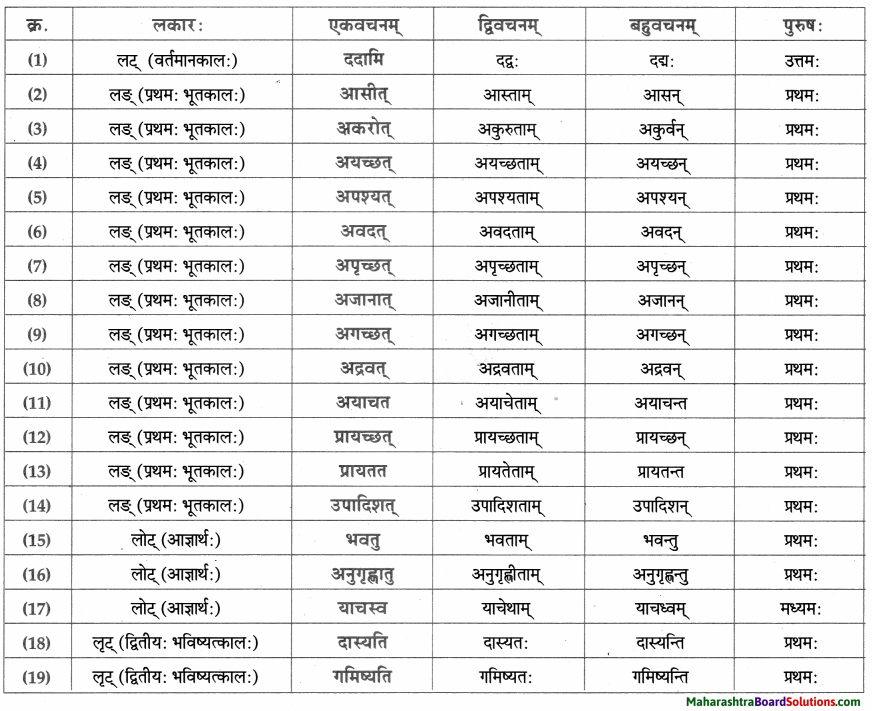
समासाः
| समस्तपदम | अर्थ: | समासविग्रहः | समासनाम |
| यमपुरम् | abode of Yama | यमस्य पुरम्। | षष्ठी तत्पुरुष समास। |
| दक्षिणारूपेण | in the form of donation | दक्षिणाया: रूपम्, तेन। | षष्ठी तत्पुरुष समास। |
| क्षुधार्त: | overcome by hunger | क्षुधया आर्तः। | तृतीया तत्पुरुष समास। |
| पिपासातः | overcome by thirst | पिपासया आर्तः। | तृतीया तत्पुरुष समास। |
| ज्ञानतृष्णा | thirst for knowledge | ज्ञानाय तृष्णा। | चतुर्थी तत्पुरुष समास। |
धातुसाधितविशेषणानि।
| धातुसाधित – विशेषणम् | विशेष्यम् |
| समाप्ते | यज्ञे |
| अनुपस्थितः, प्राप्त: | यमः |

पितृभक्तः नचिकेताः Summary in Marathi and English
प्रस्तावना :

वेद, ब्राह्मणग्रंथ, आरण्यके, उपनिषदे प्राचीन भारतीय साहित्याचा भाग आहेत. त्यातील उपनिषदे भारतीय तत्त्वज्ञानाचे मूळ आहेतच शिवाय अनेक महत्त्वाची मूल्ये सांगणाऱ्या सुंदर कथा हे त्याचे वैशिष्य आहे नचिकेता हा एक लहान हुशार मुलगा आहे जो आपल्या वडिलांना पापापासून परावृत्त करण्याचा प्रयत्न करतो. ही पितृप्रेमाची कथा आपल्याला वडीलधाऱ्यांचा आदर करायला शिकवते. “पितृदेवो भव’ हे तत्त्व सांगतानाच ही कथा प्राचीन यज्ञसंस्थेविषयी, त्यातील दानाविषयी सुद्धा सांगते.
Our ancient Vedic literature comprises of the Vedas, Brahmanas, Aranyakas and Upanishad. The Upanishads are not just a collection of philosophical concepts, but rich treasures of knowledge. Through Upanishads, absolute values can be instilled as they contain many simple yet thought-provoking stories.
There are several Upanishads through tent of them are considered the main ones. One of the ten main Upanishads is Kathopanishad. The story presented here is a part of the famous dialogue between Yama and Nachiketa from the Kathopanishad.
Nachiketa uns a young intelligent lad who tried to prevent his father afar from committing a sin. This story is one of the best examples that conveys the value of love and respect towards the father. Not only does this story depict fugeat a but also presents in what form donation can be done.
![]()
परिच्छेद : 1
वाजश्रवाः …………………. प्रियतमः ।
वाजश्रवाः नाम दानपर: ब्राह्मण: आसीत्। एकदा स: विश्वजित्-यज्ञम् अकरोत्। समाप्ते यज्ञे सः ब्राह्मणेभ्य: दक्षिणाम् अयच्छत्। दक्षिणायां सर्वदा प्रियं वस्तु यच्छेत् इति नियमः। किन्तु पिता वाजश्रवाः तु दक्षिणारूपेण दुग्धदाने असमर्थाः दुर्बलाः वृद्धाः च धेनूः अयच्छत्। तस्य पुत्र: नचिकेता: तद् अपश्यत्। असमीचीनदानेन पिता मे नरकं गमिष्यति इति भीत्या सः पितरम् अपृच्छत्, “पितः, किं तव अतीव प्रियम्?” झटिति पिता अवदत, “वत्स, त्वमेव मम प्रियतमः।”
अनुवादः
वाजश्रवा नावाचा अतिश दानशूर ब्राह्मण होता. एकदा त्याने विश्वजितयज्ञ केला. यज्ञाच्या सांगतेच्या वेळी त्याने ब्राह्मणांना दक्षिणा दिली. दक्षिणेमध्ये नेहमी सर्वात प्रिय वस्तू द्यावी असा नियम आहे.
परंतु वाजश्रव्याने दक्षिणा म्हणून दूध न देऊ शकणाऱ्या, (भाकड) अशक्त आणि म्हाताऱ्या गायी दिल्या. त्याचा मुलगा नचिकेता याने ते पाहिले. अयोग्य दानामुळे माझे वडील नरकात जातील या भितीने त्याने वडिलांना विचारले, “बाबा! तुम्हाला सगळ्यात प्रिय काय आहे?” वडिलांनी पटकन उत्तर दिले, “तूच मला सर्वात प्रिय आहेस.”
There was a charitable Brahmin named Vajashrava. Once he performed the Vishwajit sacrifice When the sacrifice was over he gave donations to the brahmins. The rule is whatever is the dearest should be donated. But father Vajashrava gave old and weak cows which were unable to give milk in the form of donation.
His son Nachiketa saw that and due to the fear that his father might attain hell on account of improper donation he asked his father, “O father, what is most dear to you?” The father immediately answered, “Child! you are dear to me.
![]()
परिच्छेद : 2
नचिकेताः पुनः अपृच्छत् …………………. प्रतीक्षाम् अकरोत्।
नचिकेताः पुन: अपृच्छत, “तर्हि मां कस्मै दास्यति भवान् ?” वाजश्रवसा किमपि उत्तरं न दत्तम्। द्विवार त्रिवार नचिकेतसा तदेव पृष्टम् । तदा कुद्धः भूत्वा पिता नचिकेतसम् ‘अहं त्वां मृत्यवे ददामि| इति अवदत्। पिता क्रोधावेशे एवम् उक्तवान् इति नचिकेताः अजानत्। तथापि पितुः आदेशपालनार्थ सः यमपुरम् अगच्छत् । यमपुरे यमः अनुपस्थितः । बाल: नचिकेता: तत्रैव त्रीणि दिनानि यावत्, किमपि अभुक्त्वा अपीत्वा यमस्य प्रतीक्षाम् अकरोत् ।
अनुवादः
नचिकेताने पुन्हा विचारले, “मग मला तुम्ही कुणाला देणार?” वाजश्रवाने काहीच उत्तर दिले नाही. नचिकेताने दोन-तीनदा परत तेच विचारले. तेव्हा चिडून वडील नचिकेताला म्हणाले, “मी तुला मृत्यूला देईन!” वडील रागाच्या भरात असे म्हणाले हे नचिकेताला कळले. तरीसुद्धा वडिलांच्या आज्ञेचे पालन करण्यासाठी तो यमपुरी गेला. यमपुरात यम नव्हता. लहानगा नचिकेता तिथेच तीन दिवस काहीही न खाता पिता यमाची वाट पाहत थांबला.
Nachiketa asked again, “Then whom will you give me to?” Vajashrava didn’t answer. Nakita asked the same question two-three times again and again. Then the father who was angry said to Nachiketa, “I’ll give you to death.”
Nachiketa knew that the father said this due to anger, yet, he went to the abode of Yama to follow his father’s order. Yama was not there in Yamapura. Young Nachiketa stayed there for three days without eating or drinking anything waiting for Yama.
![]()
परिच्छेद : 3
चतुर्थे दिवसे …………………. उपदिशत्।
चतुर्थे दिवसे यमः यमपुरं प्राप्त: । क्षुधात पिपासात बालातिथिं दृष्ट्वा तस्य हृदयं करुणया अद्रवत्। यम: नचिकेतसे ‘प्रीन् वरान् याचस्व’ इति अवदत्। ततः बालकः प्रथमं वरम् अयाचत, “मम जनकस्य वाजश्रवसः मां प्रति क्रोधः शान्त: भवतु।”
“स्वर्गसाधिकाम् अग्निविद्यां दत्त्वा माम् अनुगृह्यतु’ इति द्वितीयं वरं स: अयाचत। यम: आनन्देन वरौ प्रायच्छत्। ततः तृतीयवररूपेण नचिकेताः आत्मज्ञानम् अयाचत । तस्य प्रार्थनां श्रुत्वा यमः चकितः। न कोऽपि मर्त्यः अद्यपर्यन्तं तद् ज्ञातुकामः । अल्पवयसः बालस्य कथमिव प्रगल्भा ज्ञानतृष्णा? यमः विविधप्रलोभनै: नचिकेतसं तृतीयवरात् निवारयितुं प्रायतत। किन्तु निश्चल: नचिकेतसः निर्णयः । अन्ते वरं दातुं वचनबद्धः यम: तस्मै ज्ञानिनामपि दुर्लभम् आत्मज्ञानम् उपादिशत्।
अनुवादः
चौथ्या दिवशी यम यमपुरी आला. ताहनेने, भुकेने व्याकूळ झालेल्या त्या लानग्या अतिथीला पाहून त्याचे हृदय दयेने पिळवटले. यम नचिकेताला म्हणला, “तीन वर माग!” तेव्हा नचिकेताने पहिला वर मागितला.
“माझ्या वडिलांचा वाजश्रवांचा माझ्यावरचा राग शांत होऊ दे.” “स्वर्ग साधून देणारी अग्निविद्या देऊन माझ्यावर अनुग्रह करा.” असा दुसरा वर त्याने मागितला. यमाने आनंदाने ते दोन वर दिले. त्यानंतर तिसरा वर म्हणून नचिकेताने आत्मज्ञान मागितले.
त्याची ही विनंती ऐकून यम चकित झाला. आजपर्यंत कोणताही मर्त्य मानव आजपर्यंत इतका ज्ञान इच्छिणारा नव्हता. इतक्या लहान मुलाची इतकी प्रगल्भ ज्ञानतृष्णा?
परावृत्त करण्याचा प्रयत्न केला. परंतु नचिकेताचा निश्चय पक्का होता. शेवटी वर देण्यासाठी वचनबद्ध असलेल्या यमाने त्याला भल्या भल्या ज्ञानींसाठी दुर्लभ असणाऱ्या आत्मज्ञानाचा उपदेश केला.
यमाने इतर अनेक प्रलोभने दाखवून नचिकेताला या तिसऱ्या वरापासून On fourth day Yama arrived at his abode. यमपुर : Seeing the thirsty, hungry young guest his heart went out with compassion. Yama said to Nachiketa, “Ask for three boons!” Then the boy asked the first boon.
“May my father Vajashrava’s anger be pacified.” “Please bless me with the heavenly Agnividya”, he asked for the second boon. Yama happily bestowed him with the two boons. Then Nachiketa asked for knowledge of the self as the third boon. Yama was astonished hearing his request. Till then no mortal wished to know that.
How does this small child have such mature thirst for knowledge? Yama tried to dissuade Nachiketa from the third boon by offering different temptations. But Nachiketa’s decision was firm. In the end, being bound to give him the boon as promised, Yama bestowed him with the knowledge which is rare to even the learned.
![]()
सन्धिविग्रहः
- तद् अपश्यत् – तत् + अपश्यत्
- त्वमेव – त्वम् + एव ।
- किमपि – किम् + अपि।
- तत्रैव – तत्र + एव।
- तदेव – तत् + एव।
- कथमिव – कथम् + इव।
- शानिनामपि – ज्ञानिनाम् + अपि।
![]()
समानार्थकशब्दाः
- नाम – अभिधानम्, आख्या, नामधेयम्।
- सर्वदा – सदा, नित्यम्, सदैव ।
- दुग्धम् – क्षीरम्, पयः।
- वृद्धा – स्थविरा।
- झटिति – सत्वरम्, तूर्णम्, आशु, शीघ्रम्।
- ब्राह्मणः – द्विजाः, विप्रः, भूसुरः।
- पिता – जन्मदाता, जनकः।
- दुर्बलाः – निर्बलाः।
- धेनुः – गौः।
- दिनानि – दिवसाः।
- जनक: – पिता।
- श्रुत्वा – आकर्ण्य।
- आनन्दः – हर्षः।
- पुरम् – नगरी।
विरुद्धार्थकशब्दाः
- समाप्ते × आरम्भे।
- सर्वदा × क्वचित्।
- प्रियम् × अप्रियम्।
- दुर्बलाः × सबलाः।
- वृद्धा × युवती।
- नरक: × स्वर्ग:।
- दिवसे × रात्रौ।
- अनुपस्थितः × उपस्थितः।
- आनन्दः × दु:खः।
- निशल: × चञ्चलः।
![]()
शब्दार्थाः
- वृद्धाः – old – म्हाताऱ्या
- असमर्थाः – unable – असमर्थ
- भीत्या – due to fear – भितीने
- झटिति – fast – लवकर
- यज्ञम् – sacrifice – यज्ञ
- दक्षिणा – donation – दक्षिणा
- नियमः – rule – नियम
- दुर्बला – weak – अशक्त
- धेनूः – cows – गायी
- प्रियतमः – most dear – सर्वात प्रिय
- कुद्धः – angry – रागावलेला
- प्रतीक्षाम् अकरोत् – waited – वाट पाहिली
- अभुक्त्वा – without eating – नखाता
- अपीत्वा – without drinking – न पिता
- यमपुरम् – abode of यम – यमनगर
- अनुपस्थितः – absent – गैरहजर
- क्षुधार्त: – overcome by hunger – भुकेने व्याकूळ
- पिपासार्त: – overcome by thirst – तहानेने व्याकूळ
- हृदयम् – heart – हृदय
- वरान् – boon – वर
- आत्मज्ञानम् – self-realisation – आत्मज्ञान
- अतिथि: – guest – पाहुणा
- अल्पवयसः – of young age – लहान
- प्रगल्भा – mature – प्रगल्भ
- ज्ञानतृष्या – thirst for knowledge – ज्ञानाची तहान
- प्रलोभनम् – temptation – लालूच
- निश्चल: – firm – पक्का
- निवारयितुम् – to dissuade – परतवण्यासाठी
- मर्त्यः – mortal – मानव

